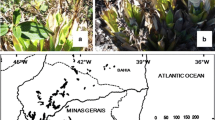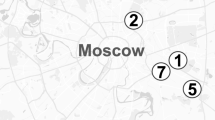Summary
From 40 habitats within a waste stabilization pond system for the treatment of sewage from a small institutional dormitory and dining hall, samples of sewage, sludges, pond waters and effluents, and undisturbed and disturbed soils were collected. From these samples and from samples of materials from an adjacent stream, 54 categories of yeasts were isolated in a year-round survey. Although all of the commoner species have been isolated from human clinical materials in past work, none of the species found has been associated with human disease conditions in temperate regions of the northern hemisphere.
All of the commoner and some of the less-common species were isolated from shaken cultures in YNB broth, with 1% and 20% glucose used as paired media. Other species, as well as all the commoner species, were obtained on broths made of YCB and YNB media to which were added different nitrogen or carbon sources. For routine surveys of populations the shaken YNB broth cultures seem adequate, but quantitative techniques must be developed for more critical delimitation of populations.
In general, within the sets of samples tested,Candida krusei, C. tropicalis, C. parapsilosis, Rhodotorula glutinis, R. mucilaginosa, andSaccharomyces cerevisiae appear indicative of organic enrichment of waters and soils.
Similar content being viewed by others
Bibliography
Alexander, M., 1961: Introduction to Soil Microbiology. John Wiley & Sons, Inc., New York, p. p. x, 472.
Anon., 1957: Sewage stabilization ponds in the Dakotas. Cincinnati. The Robert A. Taft Sanitary Engineering Center. Vol. 1, pp. 1–87, Vol. 2, Appendices 1–5.
Bohus, G., and M. Babos, 1960: Coenology of terricolous macroscopic fungi of deciduous forests. Bot. Jahrb.80 (1), 1–100.
Cooke, W. B., 1948: A survey on the literature of fungus sociology and ecology. Ecology29, 376–382.
—, 1953: A survey of literature on fungus sociology and ecology-II. Ecology34, 211–222.
—, 1955: Fungi, lichens and mosses in relation to vascular plant communities in eastern Washington and adjacent Idaho. Ecol. Monogr.25, 119–180.
Difco Laboratories, 1953: Difco Manual, Detroit, pp. 1–350.
Fenneman, N. M., 1916: Geology of Cincinnati and vicinity. Geological Survey of Ohio. Series 4, Bull.19, pp. 207. 2 maps.
Fetzmann, E. L., 1956: Beiträge zur Algensoziologie. S. B. Österr. Akad. Wiss., mathem.-naturw. KL. I,165 (9–10), 709–783.
Höfler, K., 1955: Über Pilzsoziologie. Verhandl. zool.-bot. Ges. Wien,95, 58–74.
Lange, M., 1948: The agarics of Maglemose, a study on the ecology of the agarics. Dansk Bot. Arkiv.13, 1–141.
Lodder, J., and N. J. W. Kreger-van Rij, 1952: The yeasts, a taxonomic study. North-Holland Publishing Co., Amsterdam, pp. xi, 713.
McDermott, J. H., W. B. Horning, and W. W. Towne, 1959: Recent observations at the Lebanon experimental stabilization ponds. S. E. C. Mimeographed report, pp. 1–18.
United States Geological Survey, 1927: Ohio, Mason Quadrangle. Edition of 1906, reprinted 1927.
Wickerham, L. J., 1951: Taxonomy of yeasts. U. S. D. A. Tech. Bull.1029, 1–56.
— and K. A. Burton, 1948: Carbon Assimilation tests for the classification of yeasts. J. Bact.56, 363–371.
Author information
Authors and Affiliations
Rights and permissions
About this article
Cite this article
Cooke, W.B., Matsuura, G.S. A study of yeast populations in a waste stabilization pond system. Protoplasma 57, 163–187 (1963). https://doi.org/10.1007/BF01252053
Received:
Issue Date:
DOI: https://doi.org/10.1007/BF01252053




